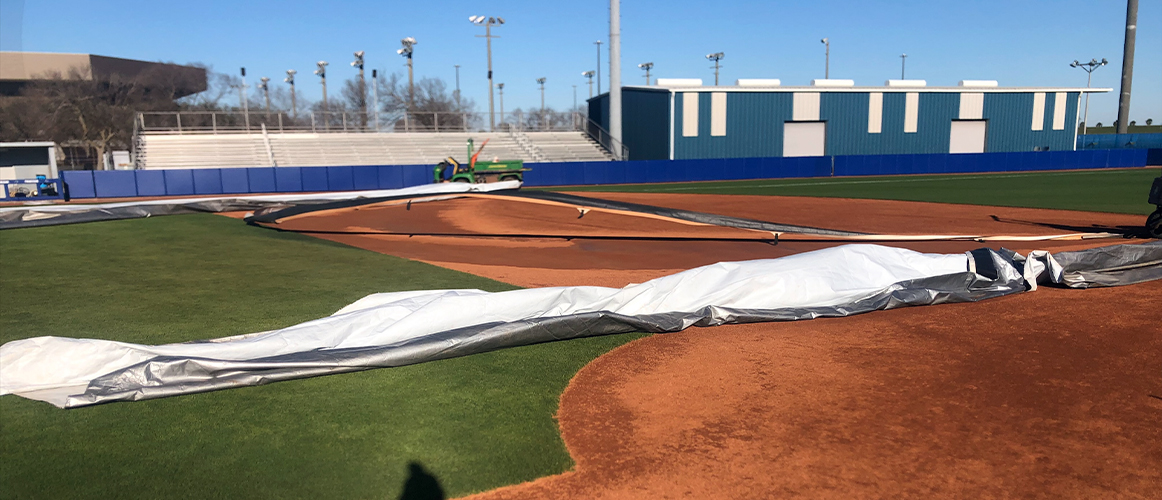The University of New Orleans’ proximity to Lake Pontchartrain provides a picturesque setting for baseball fans who come to Maestri Field to cheer on their Privateers.
It also presents a unique set of challenges for Sports Turf Manager Scott Blanchette of ABM Industries, whose job is to keep the field safe for players and staff and looking good for fans, no matter what Louisiana’s unpredictable weather throws at him.
“With us being on the lake, it’s windy all the time,” said Blanchette, who regularly asks himself one question with no easy answer—to tarp or not to tarp?
Deploying your tarp when a storm’s coming may seem like a no-brainer—it keeps rainwater from saturating the dirt infield and surrounding turf, which can save field crews hours of work on game days.
Tarping isn’t always a good idea, however.
A storm that turned unexpectedly severe overnight destroyed UNO’s 1,185-pound, 160-foot by 160-foot tarp in April. Though Blanchette and his student crew followed the standard practice of securing the tarp with weights and heavy equipment, he arrived that game day morning to find it in three pieces on the rain-soaked field.
Field prep that would normally take about 45 minutes had the tarp held took more than six hours.
“We were able to get the field ready in time to play,” Blanchette said, but despite avoiding a game delay, he has no desire to repeat the experience of removing large pieces of tarp in 20- to 30-mph winds while drying out his field.
He no longer relies on heavy equipment to secure tarp corners. Now, in addition to the weights, he uses stakes for extra security.
What to Consider When Making the Decision to Tarp
Always an avid weather-watcher, Blanchette is even more so now. If there’s a chance of a major wind event associated with a pending storm, he may not roll out the tarp, but it’s not an automatic “no.” He weighs several factors when making his final decision, including predicted severity of the storm, humidity, game time, crew availability, and post-storm forecast.
Blanchette’s advice to field managers trying to decide whether to use their tarp or keep it rolled up:
- Watch the radar and the local news to see what’s happening now and what’s expected to happen in the next 24 hours, then look beyond the daily forecast. If clear, sunny skies are forecast after extreme weather tonight and there’s enough time to dry out your field without scrambling, rolling out the tarp may not be worth the risk.
- Ask yourself the following questions: What am I seeing and what am I hearing? When is the game scheduled to start and can we change it if we need more time to get the field ready? How big of a game is it and what are the stakes? If the Privateers are taking on their top rivals, the Louisiana State University Tigers, that will factor into Blanchette’s decision.
- As field manager, you have the final say. Listen to others’ recommendations but remember you’re the person following the radar and the forecasts closely, not others, and the decision is ultimately yours.
Looking for Field Cover Solutions? Ewing Can Help
Field covers come in multiple shapes, sizes, and thicknesses, and recommendations for securing them vary by manufacturer.
For large tarps, one manufacturer recommends placing sandbags every 5 feet around the entire perimeter and adding a row of sandbags down the middle if needed. Higher, straight-line winds require additional weight.
Field managers looking for help deciding what type of tarp is best for their field and best practices for securing the one they choose can reach out to their Ewing account manager, drop by their local Ewing location, or visit Ewing’s Sports Field Maintenance page at EwingIrrigation.com.




